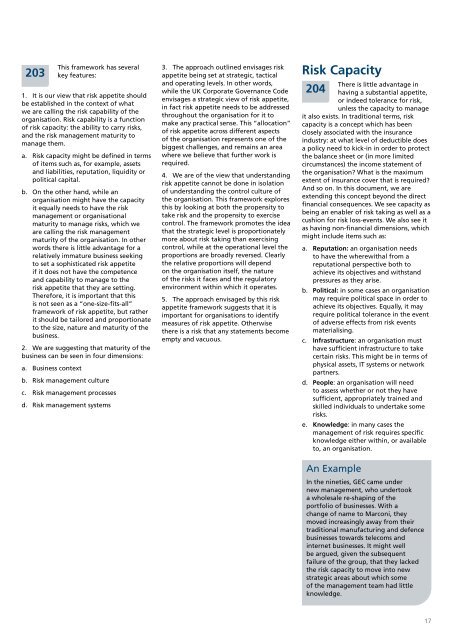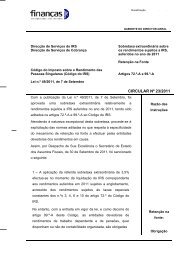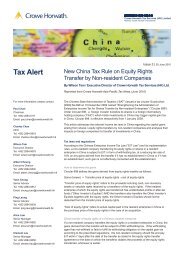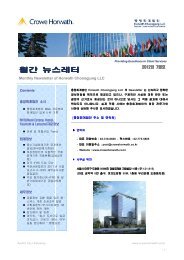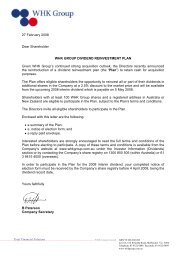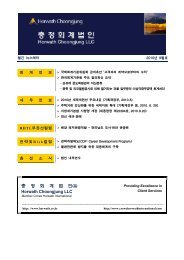Guidance Paper - The Institute of Risk Management
Guidance Paper - The Institute of Risk Management
Guidance Paper - The Institute of Risk Management
You also want an ePaper? Increase the reach of your titles
YUMPU automatically turns print PDFs into web optimized ePapers that Google loves.
203<br />
This framework has several<br />
key features:<br />
1. It is our view that risk appetite should<br />
be established in the context <strong>of</strong> what<br />
we are calling the risk capability <strong>of</strong> the<br />
organisation. <strong>Risk</strong> capability is a function<br />
<strong>of</strong> risk capacity: the ability to carry risks,<br />
and the risk management maturity to<br />
manage them.<br />
a. <strong>Risk</strong> capacity might be defined in terms<br />
<strong>of</strong> items such as, for example, assets<br />
and liabilities, reputation, liquidity or<br />
political capital.<br />
b. On the other hand, while an<br />
organisation might have the capacity<br />
it equally needs to have the risk<br />
management or organisational<br />
maturity to manage risks, which we<br />
are calling the risk management<br />
maturity <strong>of</strong> the organisation. In other<br />
words there is little advantage for a<br />
relatively immature business seeking<br />
to set a sophisticated risk appetite<br />
if it does not have the competence<br />
and capability to manage to the<br />
risk appetite that they are setting.<br />
<strong>The</strong>refore, it is important that this<br />
is not seen as a “one-size-fits-all”<br />
framework <strong>of</strong> risk appetite, but rather<br />
it should be tailored and proportionate<br />
to the size, nature and maturity <strong>of</strong> the<br />
business.<br />
2. We are suggesting that maturity <strong>of</strong> the<br />
business can be seen in four dimensions:<br />
a. Business context<br />
b. <strong>Risk</strong> management culture<br />
c. <strong>Risk</strong> management processes<br />
d. <strong>Risk</strong> management systems<br />
3. <strong>The</strong> approach outlined envisages risk<br />
appetite being set at strategic, tactical<br />
and operating levels. In other words,<br />
while the UK Corporate Governance Code<br />
envisages a strategic view <strong>of</strong> risk appetite,<br />
in fact risk appetite needs to be addressed<br />
throughout the organisation for it to<br />
make any practical sense. This “allocation”<br />
<strong>of</strong> risk appetite across different aspects<br />
<strong>of</strong> the organisation represents one <strong>of</strong> the<br />
biggest challenges, and remains an area<br />
where we believe that further work is<br />
required.<br />
4. We are <strong>of</strong> the view that understanding<br />
risk appetite cannot be done in isolation<br />
<strong>of</strong> understanding the control culture <strong>of</strong><br />
the organisation. This framework explores<br />
this by looking at both the propensity to<br />
take risk and the propensity to exercise<br />
control. <strong>The</strong> framework promotes the idea<br />
that the strategic level is proportionately<br />
more about risk taking than exercising<br />
control, while at the operational level the<br />
proportions are broadly reversed. Clearly<br />
the relative proportions will depend<br />
on the organisation itself, the nature<br />
<strong>of</strong> the risks it faces and the regulatory<br />
environment within which it operates.<br />
5. <strong>The</strong> approach envisaged by this risk<br />
appetite framework suggests that it is<br />
important for organisations to identify<br />
measures <strong>of</strong> risk appetite. Otherwise<br />
there is a risk that any statements become<br />
empty and vacuous.<br />
<strong>Risk</strong> Capacity<br />
204<br />
<strong>The</strong>re is little advantage in<br />
having a substantial appetite,<br />
or indeed tolerance for risk,<br />
unless the capacity to manage<br />
it also exists. In traditional terms, risk<br />
capacity is a concept which has been<br />
closely associated with the insurance<br />
industry: at what level <strong>of</strong> deductible does<br />
a policy need to kick-in in order to protect<br />
the balance sheet or (in more limited<br />
circumstances) the income statement <strong>of</strong><br />
the organisation What is the maximum<br />
extent <strong>of</strong> insurance cover that is required<br />
And so on. In this document, we are<br />
extending this concept beyond the direct<br />
financial consequences. We see capacity as<br />
being an enabler <strong>of</strong> risk taking as well as a<br />
cushion for risk loss-events. We also see it<br />
as having non-financial dimensions, which<br />
might include items such as:<br />
a. Reputation: an organisation needs<br />
to have the wherewithal from a<br />
reputational perspective both to<br />
achieve its objectives and withstand<br />
pressures as they arise.<br />
b. Political: in some cases an organisation<br />
may require political space in order to<br />
achieve its objectives. Equally, it may<br />
require political tolerance in the event<br />
<strong>of</strong> adverse effects from risk events<br />
materialising.<br />
c. Infrastructure: an organisation must<br />
have sufficient infrastructure to take<br />
certain risks. This might be in terms <strong>of</strong><br />
physical assets, IT systems or network<br />
partners.<br />
d. People: an organisation will need<br />
to assess whether or not they have<br />
sufficient, appropriately trained and<br />
skilled individuals to undertake some<br />
risks.<br />
e. Knowledge: in many cases the<br />
management <strong>of</strong> risk requires specific<br />
knowledge either within, or available<br />
to, an organisation.<br />
An Example<br />
In the nineties, GEC came under<br />
new management, who undertook<br />
a wholesale re-shaping <strong>of</strong> the<br />
portfolio <strong>of</strong> businesses. With a<br />
change <strong>of</strong> name to Marconi, they<br />
moved increasingly away from their<br />
traditional manufacturing and defence<br />
businesses towards telecoms and<br />
internet businesses. It might well<br />
be argued, given the subsequent<br />
failure <strong>of</strong> the group, that they lacked<br />
the risk capacity to move into new<br />
strategic areas about which some<br />
<strong>of</strong> the management team had little<br />
knowledge.<br />
17


